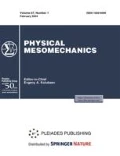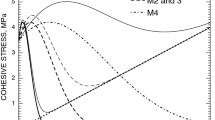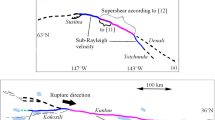Abstract
This paper is a brief review of the main recent results obtained by studying fault slip processes. The published hypotheses and data are analyzed within the approach proposed by Panin, according to which the subsurface is considered as a multilevel hierarchically organized system where all processes evolve consistently at the nano-, micro-, meso- and macroscale levels. The review focuses on the hierarchy of structures that, according to modern concepts, form the seismogenic fault slip zone. The relationship of the structures with the mechanical characteristics of localized slip surfaces and microcontacts determining the slip dynamics of fault zones at the macrolevel is discussed. It is shown that the evolution of the contact properties of filler particles in the slip zone determines not only the occurrence of instability, but also the ability of a fault to recover strength with time. The simplest scheme of the hierarchy of macroscopic asperities is described to support the important principle that the initiation, evolution and arrest of a seismogenic fault depend on the size and relative position of regions with different dynamics of frictional characteristics during slip. The performed analysis of the results of field observations shows that because of the insufficient accuracy of observations and the ambiguous interpretation of the inverse problem solution, it is impossible to correctly identify fault segments with the velocity weakening property. The size and location of these zones can be more accurately determined from the analysis of records of high-frequency oscillations in the vicinity of an earthquake rupture. The basic principles of physical mesomechanics provide a good basis for the interpretation of such results.









Similar content being viewed by others
Change history
31 August 2021
Corrected issue title
REFERENCES
Cailleus, A. and Tricart, J., Le problème de la Classification des Faits Géomorphologiques, Annales de Géographie, 1956, vol. 65, no. 349, pp. 162–186.
Piotrovskii, V.V., Application of Morphometry to Studies of the Earth’s Relief and Structure, in The Earth in the Universe, Fedynskii, Ed., Jerusalem: Israel Program for Scientific Translations, 1968, pp. 228–243.
Sadovsky, M.A., Bolkhovitinov, L.G., and Pisarenko, V.F., Deformation of the Geophysical Medium and Seismic Process, Moscow: Nauka, 1987.
Rodionov, V.N., Sizov, I.A., and Tsvetkov, V.M., Fundamentals of Geomechanics, Moscow: Nedra, 1986.
Kocharyan, G.G. and Spivak, A.A., Dynamics of Rock Deformation, Moscow: Akademkniga, 2003.
Panin, V.E., Foundations of Physical Mesomechanics, Phys. Mesomech., 1998, vol. 1, no. 1, pp. 5–20.
Panin, V.E., Egorushkin, V.E., and Panin, A.V., Physical Mesomechanics of a Deformed Solid as a Multilevel System. I. Physical Fundamentals of the Multilevel Approach, Phys. Mesomech., 2006, vol. 9, no. 3–4, pp. 9–20.
Panin, V.E. and Egorushkin, V.E., Deformable Solid as a Nonlinear Hierarchically Organized System, Phys. Mesomech., 2011, vol. 14, no. 5–6, pp. 207–223.
Panin, V.E., Fomin, V.M., and Titov, V.M., Physical Principles of Mesomechanics of Surface Layers and Internal Interfaces in a Solid under Deformation, Phys. Mesomech., 2003, vol. 6, no. 3, pp. 5–13.
Scholz, C.H., Paradigms or Small Change in Earthquake Mechanics, in Fault Mechanics and Transport Properties of Rocks, Evans, B. and Wang, T., Eds., Academic Press Limited, 1992, pp. 505–517.
Chinnery, M.A., The Strength of the Earth’s Crust under Horizontal Shear Stress, J. Geophys. Res., 1964, vol. 69, pp. 2085–2089.
Brace, W.F. and Byerlee, J.D., Stick-Slip as a Mechanism for Earthquakes, Science, 1966, vol. 153, pp. 990–992.
Kanamori, H. and Stewart, G.S., Seismological Aspects of the Guatemala Earthquake of February 4, 1976, J. Geophys. Res., 1978, vol. 83, pp. 3427–3434.
Ruzhich, V.V. and Kocharyan, G.G., On the Structure and Formation of Earthquake Sources in the Faults Located in the Subsurface and Deep Levels of the Crust. I. Subsurface Level, Geodin. Tektonofiz., 2017, vol. 8, no. 4, pp. 1021–1034. https://doi.org/10.5800/GT-2017-8-4-0330
Rebetsky, Yu.L., Regularities of Crustal Faulting and Tectonophysical Indicators of Fault Metastability, Geodin. Tektonofiz., 2018, vol. 9, no. 3, pp. 629–652. https://doi.org/10.5800/GT-2018-9-3-0365
Byerlee, J.D., Friction of Rocks, Pure. Appl. Geophys., 1978, vol. 116, pp. 615–626.
Scholz, C.H., The Mechanics of Earthquakes and Faulting, Cambridge: Cambridge University Press, 2002.
Marone, C., Laboratory Derived Friction Laws and Their Application to Seismic Faulting, Ann. Rev. Earth Planet. Sci., 1998, vol. 26, pp. 643–696.
Mandelbrot, B., The Fractal Geometry of Nature, San Francisco: Freeman, 1982.
Power, W.L., Tullis, T.E., Brown, S.R., Boitnott, G.N., and Scholz, C.H., Roughness of Natural Fault Surfaces, Geophys. Res. Lett., 1987, vol. 14, pp. 29–32.
Kocharyan, G.G. and Kulyukin, A.M., Study of Caving Features for Underground Workings in a Rock Mass of Block Structure with Dynamic Action. Part II. Mechanical Properties of Interblock Gaps, J. Mining Sci., 1994, vol. 30, no. 5, pp. 437–446. https://doi.org/10.1007/BF02047334
Bouchaud, E., Scaling Properties of Cracks, J. Phys. Condens. Matter., 1997, vol. 9, pp. 4319–4344.
Sagy, A. and Brodsky, E.E., Geometric and Rheological Asperities in an Exposed Fault Zone, J. Geophys. Res. B, 2009, vol. 114, p. 02301. https://doi.org/10.1029/2008JB005701
Amitrano, D. and Schmittbuhl, J., Fracture Roughness and Gouge Distribution of a Granite Shear Band, J. Geophys. Res. B, 2002, vol. 107, no. 12. p. 2375. https://doi.org/10.1029/2002JB001761
Brodsky, E.E., Kirkpatrick, J.D., and Candela, T., Constraints from Fault Roughness on the Scale-Dependent Strength of Rocks, Geology, 2016, vol. 44, no. 1, pp. 19–22. https://doi.org/10.1130/G37206.1
Chen, X., Madden, A.S., Bickmore, B.R., and Reches, Z., Dynamic Weakening by Nanoscale Smoothing during High-Velocity Fault Slip, Geology, 2013, vol. 41, no. 7, pp. 739–742. https://doi.org/10.1130/G34169.1
Kocharyan, G.G., Geomechanics of Faults, Moscow: GEOS, 2016.
Candela, T., Renard, F., Bouchon, M., Schmittbuhl, J., and Brodsky, E.E., Stress Drop during Earthquakes: Effect of Fault Roughness Scaling, Bull. Seismol. Soc. Am., 2011, vol. 101, no. 5, pp. 2369–2387. https://doi.org/10.1785/0120100298
Selvadurai, P.A. and Glaser, S.D., Asperity Generation and Its Relationship to Seismicity on a Planar Fault: A Laboratory Simulation, Geophys. J. Int., 2017, vol. 208, pp. 1009–1025.
Sagy, A., Brodsky, E.E., and Axen, G.J., Evolution of Fault-Surface Roughness with Slip, Geology, 2007, vol. 35, pp. 283–286. https://doi.org/10.1130/G23235A.1
Chen, X., Carpenter, B.M., and Reches, Z., Asperity Failure Control of Stick–Slip along Brittle Faults, Pure Appl. Geophys., 2020, vol. 177, pp. 3225–3242. https://doi.org/10.1007/s00024-020-02434-y
Tabor, D., Interaction between Surfaces: Adhesion and Friction, in Surface Physics of Materials, Blakely, J.M., Ed., Ch. 10, New York: Academic Press, 1975.
Ruzhich, V.V. and Sherman, S.I., Estimation of the Relation between the Length and Amplitude of Fault Displacements, in Crustal Dynamics in Eastern Siberia, Novosibirsk: Nauka, 1978, pp. 52–57.
Wang, K. and Bilek, S.L., Fault Creep Caused by Subduction of Rough Seafloor Relief, Tectonophysics, 2014, vol. 610, pp. 1–24.
Rice, J.R., Heating and Weakening of Faults during Earthquake Slip, J. Geophys. Res. B, 2006, vol. 111, no. 5, p. 05311. https://doi.org/10.1029/2005JB004006
Chester, F.M. and Chester, J.S., Ultracataclasite Structure and Friction Processes of the Punchbowl Fault, San Andreas System, California, Tectonophysics, 1998, vol. 295, pp. 199–221.
Chester, J.S., Chester, F.M., and Kronenberg, A.K., Fracture Surface Energy of the Punchbowl Fault, San Andreas System, Nature, 2005, vol. 437, pp. 133–136.
Sibson, R.H., Thickness of the Seismic Slip Zone, Bull. Seismol. Soc. Am., 2003, vol. 93, no. 3, pp. 1169–1178.
Reches, Z. and Lockner, D.A., Fault Weakening and Earthquake Instability by Powder Lubrication, Nature, 2010, vol. 467, pp. 452–455. https://doi.org/10.1038/nature09348.39
Boneh, Y. and Reches, Z., Geotribology—Friction, Wear, and Lubrication of Faults, Tectonophysics, 2018, vol. 733, pp. 171–181. https://doi.org/10.1016/j.tecto.2017.11.022
Ruff, L. and Kanamori, H., Seismic Coupling and Uncoupling at Subduction Zones, Tectonophysics, 1983, vol. 99, no. 2–4, pp. 99–117. https://doi.org/10.1016/0040-1951(83)90097-5
Tichelaar, B.W. and Ruff, L.J., Depth of Seismic Coupling along Subduction Zones, J. Geophys. Res. B, 1993, vol. 98, no. 2, pp. 2017–2037. https://doi.org/10.1029/92JB02045
Kocharyan, G.G. and Novikov, V.A., Experimental Study of Different Modes of Block Sliding along Interface. Part 1. Laboratory Experiments, Phys. Mesomech., 2016, vol. 9, no. 2, pp. 189–199. https://doi.org/10.1134/S1029959916020120
Budkov, A.M. and Kocharyan, G.G., Experimental Study of Different Modes of Block Sliding along Interface. Part 3. Numerical Modeling, Phys. Mesomech., 2017, vol. 20, no. 2, pp. 203–208. https://doi.org/10.1134/S1029959917020102
Kocharyan, G.G., Novikov, V.A., Ostapchuk, A.A., and Pavlov, D.V., A Study of Different Fault Slip Modes Governed by the Gouge Material Composition in Laboratory Experiments, Geophys. J. Int., 2017, vol. 208, pp. 521–528. https://doi.org/10.1093/gji/ggw409
Dieterich, J.H., Modeling of Rock Friction: 1. Experimental Results and Constitutive Equations, J. Geophys. Res., 1979, vol. 84, pp. 2161–2168.
Ruina, A.L., Slip Instability and State Variable Friction Laws, J. Geophys. Res., 1983, vol. 88, pp. 10359–10370.
Rice, J.R., Fault Stress States, Pore Pressure Distributions, and the Weakness of the San Andreas Fault, in Fault Mechanics and Transport Properties of Rocks, Evans, B. and Wong, T.-F., Eds., 1992, pp. 475–504.
Reches, Z., Chen, X., and Carpenter, B., Asperity Failure Control of Stick-Slip along Brittle Faults, Pure Appl. Geophys., 2020. https://doi.org/10.1007/s00024-020-02434-y
Ikari, M.J., Marone, C., Saffer, D.M., and Kopf, A.J., Slip Weakening as a Mechanism for Slow Earthquakes, Nature Geosci., 2013, vol. 6, pp. 468–472. https://doi.org/10.1038/NGEO18198
Carpenter, B.M., Ikari, M.J., and Marone, C., Laboratory Observations of Time-Dependent Frictional Strengthening and Stress Relaxation in Natural and Synthetic Fault Gouges, J. Geophys. Res. Solid Earth., 2016, vol. 121, pp. 1183–1201. https://doi.org/10.1002/2015JB012136
Scholz, C.H. and Campos, J., The Seismic Coupling of Subduction Zones Revisited, J. Geophys. Res. B, 2012, vol. 117, p. 05310. https://doi.org/10.1029/2011JB009003
Ruzhich, V.V., Medvedev, V.Ya., and Ivanova, L.A., Healing of Seismogenic Ruptures and Earthquake Recurrence, in Seismicity of the Baikal Rift. Prognostic Aspects, Novosibirsk: Nauka, 1990, pp. 44–50.
Tenthorey, E., Cox, S.F., and Todd, H.F., Evolution of Strength Recovery and Permeability during Fluid-Rock Reaction in Experimental Fault Zones, Earth Planet. Sci. Lett., 2003, vol. 206, pp. 161–172.
Turcotte, D. and Schubert, J., Geodynamics: Application of Continuum Physics to Geological Problems, New York: John Wiley and Sons, 1982.
Beeler, N. and Hickman, S., Stress-Induced, Time-Dependent Fracture Closure at Hydrothermal Conditions, J. Geophys. Res., 2004, vol. 109. https://doi.org/10.1029/2002JB001782
Niemeijer, A., Marone, C., and Elsworth, D., Healing of Simulated Fault Gouges Aided by Pressure Solution: Results from Rock Analogue Experiments, J. Geophys. Res. B, 2008, vol. 113, p. 04204. https://doi.org/10.1029/2007JB005376
Tenthorey, E. and Cox, S.F., Cohesive Strengthening of Fault Zones during the Interseismic Period: An Experimental Study, J. Geophys. Res. B, 2006, vol. 111, p. 09202. https://doi.org/10.1029/2005JB004122
Ikari, M.J., Carpenter, B.M., and Marone, C., A Microphysical Interpretation of Rate- and State Dependent Friction for Fault Gouge, Geochem. Geophys. Geosyst., 2016, vol. 17, pp. 1660–1677. https://doi.org/10.1002/2016GC006286
Chester, F.M. and Higgs, N.G., Multimechanism Friction Constitutive Model for Ultrafine Quartz Gouge at Hypocentral Locations, J. Geophys. Res., 1992, vol. 97, pp. 1859–1870.
Johnson, K.L., Contact Mechanics, Cambridge University Press, 1985.
Popov, V.L., Contact Mechanics and Friction. Physical Principles and Applications, Berlin: Springer–Verlag, 2010.
Batukhtin, I.V., Budkov, A.M., and Kocharyan, G.G., Features of Initiation and Rupture with Heterogeneous Fault Surfaces, in Trigger Effects in Geosystem, Proc. of the V Int. Conf., 2019, pp. 137–149.
Kocharyan, G.G. and Pavlov, D.V., Damage and Healing of Fault Zones in Rock, Fiz. Mezomekh., 2007, vol. 10, no. 1, pp. 5–18.
Uchida, N. and Burgmann, R., Repeating Earthquakes, Annu. Rev. Earth Planet. Sci., 2019, vol. 47, pp. 305–332.
Metois, M., Vigny, C., and Socquet, A., Interseismic Coupling, Megathrust Earthquakes and Seismic Swarms along the Chilean Subduction Zone (38º–18ºS), Pure Appl. Geophys., 2017, vol. 173, no. 5, pp. 1431–1449. https://doi.org/10.1007/s00024-016-1280-5
Godano, M., Bernard, P., and Dublanchet, P., Bayesian Inversion of Seismic Spectral Ratio for Source Scaling: Application to a Persistent Multiplet in the Western Corinth Rift, J. Geophys. Res. Solid Earth, 2015, vol. 120, pp. 7683–7712. https://doi.org/10.1002/2015JB012217
Matsuzawa, T., Igarashi, T., and Hasegawa, A. Characteristic Small-Earthquake Sequence off Sanriku, Northeastern Honshu, Japan, Geohpys. Res. Lett., 2002, vol. 29, no. 11, p. 1543. https://doi.org/10.1029/2001GL014632
Okada, T., Matsuzawa, T., and Hasegawa, A., Comparison of Source Areas of M4.8 ± 0.1 Repeating Earthquakes off Kamaishi, NE Japan—Are Asperities Persistent Features?, Earth Planet. Sci. Lett., 2003, vol. 213, pp. 361–374.
Bie, L., Hicks, S., Garth, T., Gonzalez, P., and Rietbrock, A., Two Go Together’: Near-Simultaneous Moment Release of Two Asperities during the 2016 Mw6.6 Muji, China Earthquake, Earth Planet. Sci. Lett., 2018, vol. 491, pp. 34–42. https://doi.org/10.1016/j.epsl.2018.03.033
Yamanaka, Y. and Kikuchi, M., Asperity Map along the Subduction Zone in Northeastern Japan Inferred from Regional Seismic Data, J. Geophys. Res. B, 2004, vol. 109, p. 07307. https://doi.org/10.1029/2003JB002683
Freymueller, J.T., Cohen, S.C., and Fletcher, H.J., Spatial Variations in Present-Day Deformation, Kenai Peninsula, Alaska, and Their Implications, J. Geophys. Res., 2000, vol. 105, pp. 8079–8101.
Zhang, X.F., Wanpeng, H., Li, D., Wang, L., Shuai, Y., Wang, L., and Yongzhe, The 2018 Mw7.5 Papua New Guinea Earthquake: A Dissipative and Cascading Rupture Process, Geophys. Res. Lett., 2020, vol. 47. https://doi.org/10.1029/2020GL089271
Funding
The study was carried out with the financial support of the Russian Foundation for Basic Research within scientific project No. 20-55-53031.
Author information
Authors and Affiliations
Corresponding author
Additional information
In memory of Academician Victor Panin, the founder of physical mesomechanics
Rights and permissions
About this article
Cite this article
Kocharyan, G.G., Kishkina, S.B. The Physical Mesomechanics of the Earthquake Source. Phys Mesomech 24, 343–356 (2021). https://doi.org/10.1134/S1029959921040019
Received:
Revised:
Accepted:
Published:
Issue Date:
DOI: https://doi.org/10.1134/S1029959921040019




